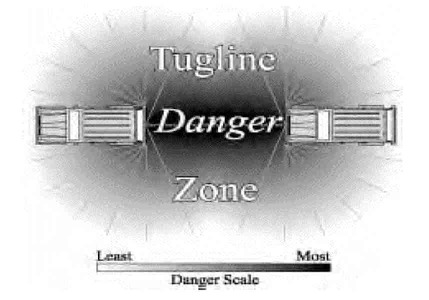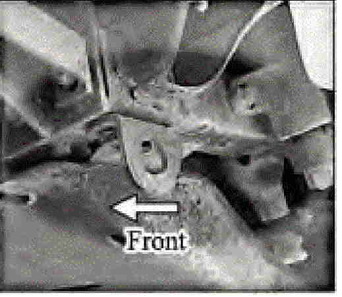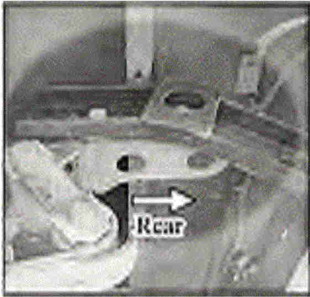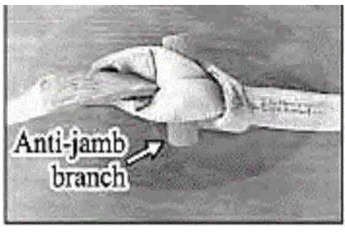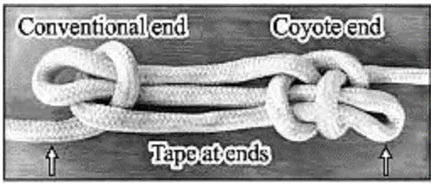| |||||||
Tugging Basics
Story and Photos by Harry Lewellyn
INTRODUCTION
Repeating from last month: "Let there be no doubt: Towing and tugging one vehicle with another can be dangerous. In your well-meaning attempt to help, you can do serious harm. And that should come as no surprise when you consider the size, weight, horsepower and rock-throwing tires on the vehicles we take off road. It is easier than you think to break parts and injure people when towing and tugging." Tugging can be treacherous! Define, enforce and respect a danger zone encompassing the work area, as shown below and explained below.
Repeating from last month: "Let there be no doubt: Towing and tugging one vehicle with another can be dangerous. In your well-meaning attempt to help, you can do serious harm. And that should come as no surprise when you consider the size, weight, horsepower and rock-throwing tires on the vehicles we take off road. It is easier than you think to break parts and injure people when towing and tugging." Tugging can be treacherous! Define, enforce and respect a danger zone encompassing the work area, as shown below and explained below.
TREACHEROUS TUGGING
If towing is dangerous, then tugging is treacherous. It requires a crawl, walk, and then finally the deadly "run" approach, only when absolutely necessary. To start off running, with little or no experience, is irresponsible. This article builds on the previous two FOURWHEELING ACADEMIES and in no way should be considered a stand-alone source for tugging. I make frequent reference to YANKERS AWAY (September-October '99) and TOWING BASICS. (November-December '99). So let's first chill your spine with a few horror stories, hear how others helped me improve TOWING BASICS, then get on with how to tug.
HORROR STORIES
Tightly stretched things of any sort can be deadly … if they break or come loose! How about a few wakeup horror stories of unknown origin? There's the one about the strap with a metal hook that broke loose from its attach point. The hook came through the pickup's back window and killed the driver with a blow to the back of his head. Same story, but this time through the windshield, with a trailer ball, in the face! Different strap, spectator too close, strap cuts off legs. Another version except this time it's the onlooker's head! Think of everything you use to attach two vehicles together for towing or tugging as howitzer-size slingshots!
Here's a true tale of what happened to my lumberjack uncle with just a ridged cable. His log-towing cable breaks, snaps forward and wraps and crushes him to the open seat of his Caterpillar. Several months in the hospital straightened out a couple of broken ribs, arm and damaged internal organs. Taut things of any sort can be deadly if they break or come loose! Don't take tugging loosely!
FEEDBACK
Fellow engineer Ken Obenski, P.E. (San Diego, CA) had several comments. I may have misled you when I said, regarding welding tow hooks to the frame, "… crystallizes and becomes very brittle - weak." He correctly points out all metals are crystalline structures and I should have more accurately said recrystallizes. He goes on to clarify that Department of Transportation holes are only required on vehicles that will be carried on car carriers. He owns "Big Mama," the 4X Chevy Van that towed me up from Urique Canyon in the Copper Canyon complex (see Bury my Ford in Cerocahui, January '98). Actually, it's wife Cindy's regular transportation. Since it's a 2WD to 4WD conversion, it lacks D-holes in the front. That may be due to the 4WD mod or that it was never designed to be hauled on a car carrier. Finally, he points out that a slip hook, when attached to a D-hole, puts the full stress on the hook. More on this later.
Myrna Wosk (La Jolla, CA) noticed her Toyota had another kind of "D-hole" attach plate. See below for two Toyota variations that I would be skeptical of using in an all-out tug. I have no idea how many different D-holes there are in the world and would welcome your enlightenments. These will be used to continually update Web material.
If towing is dangerous, then tugging is treacherous. It requires a crawl, walk, and then finally the deadly "run" approach, only when absolutely necessary. To start off running, with little or no experience, is irresponsible. This article builds on the previous two FOURWHEELING ACADEMIES and in no way should be considered a stand-alone source for tugging. I make frequent reference to YANKERS AWAY (September-October '99) and TOWING BASICS. (November-December '99). So let's first chill your spine with a few horror stories, hear how others helped me improve TOWING BASICS, then get on with how to tug.
HORROR STORIES
Tightly stretched things of any sort can be deadly … if they break or come loose! How about a few wakeup horror stories of unknown origin? There's the one about the strap with a metal hook that broke loose from its attach point. The hook came through the pickup's back window and killed the driver with a blow to the back of his head. Same story, but this time through the windshield, with a trailer ball, in the face! Different strap, spectator too close, strap cuts off legs. Another version except this time it's the onlooker's head! Think of everything you use to attach two vehicles together for towing or tugging as howitzer-size slingshots!
Here's a true tale of what happened to my lumberjack uncle with just a ridged cable. His log-towing cable breaks, snaps forward and wraps and crushes him to the open seat of his Caterpillar. Several months in the hospital straightened out a couple of broken ribs, arm and damaged internal organs. Taut things of any sort can be deadly if they break or come loose! Don't take tugging loosely!
FEEDBACK
Fellow engineer Ken Obenski, P.E. (San Diego, CA) had several comments. I may have misled you when I said, regarding welding tow hooks to the frame, "… crystallizes and becomes very brittle - weak." He correctly points out all metals are crystalline structures and I should have more accurately said recrystallizes. He goes on to clarify that Department of Transportation holes are only required on vehicles that will be carried on car carriers. He owns "Big Mama," the 4X Chevy Van that towed me up from Urique Canyon in the Copper Canyon complex (see Bury my Ford in Cerocahui, January '98). Actually, it's wife Cindy's regular transportation. Since it's a 2WD to 4WD conversion, it lacks D-holes in the front. That may be due to the 4WD mod or that it was never designed to be hauled on a car carrier. Finally, he points out that a slip hook, when attached to a D-hole, puts the full stress on the hook. More on this later.
Myrna Wosk (La Jolla, CA) noticed her Toyota had another kind of "D-hole" attach plate. See below for two Toyota variations that I would be skeptical of using in an all-out tug. I have no idea how many different D-holes there are in the world and would welcome your enlightenments. These will be used to continually update Web material.
"Loop-through-loops" drew comments from Frank Harris (Ramona, CA) and Jay Center (Mission Viejo, CA). Both suggested what I'll call an "anti-jamb" separator to join two flat strap loops. See below left and understand the last step would be to tape the anti-jamb in place (not shown). It would certainly simplify untying (have tested it) and I believe (never tested it) round material like a dowel or branch will stress the straps less than, say, a sharp-cornered 2x4 or other rectangular material. My only reservation with this, as they both pointed out, is you've added a "cannonball" to the circuit.
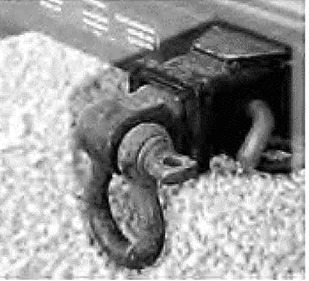
A class III shackle insert
Frank adds that a sheepshank is a nautical way to shorten a rope. Note I've shown the conventional knot (left end) and the Coyote version (right end) in the above right illustration. My past experience with a trucker's knot (a half sheepshank of a sort) has shown the double loop (half hitch) approach withstands more stress. And with a little tape at the ends, you'll ensure either approach stays tied with and without stress.
Blaine Johnson (Dana Point, CA) suspects the class III trailer receiver pin through yanker loop may bend the pin. I've broken pinned yellow yankers and the pin remained straight, but have never tested round towlines. They would definitely centralize the force on the pin and could bend it. His comment brought to mind another towing and tugging class III insert. See at right.
My crawl, then walk and finally run approach definitely applies to tugging. Don't go for the gold on the first jerk. The balance of this article assumes you have the two vehicles properly attached to each other, both vehicles' paths are clear and the stuck vehicle is safe to move. Above all, make sure the brakes and steering work on both vehicles, and both drivers have calmed down from whatever caused the problem.
Blaine Johnson (Dana Point, CA) suspects the class III trailer receiver pin through yanker loop may bend the pin. I've broken pinned yellow yankers and the pin remained straight, but have never tested round towlines. They would definitely centralize the force on the pin and could bend it. His comment brought to mind another towing and tugging class III insert. See at right.
My crawl, then walk and finally run approach definitely applies to tugging. Don't go for the gold on the first jerk. The balance of this article assumes you have the two vehicles properly attached to each other, both vehicles' paths are clear and the stuck vehicle is safe to move. Above all, make sure the brakes and steering work on both vehicles, and both drivers have calmed down from whatever caused the problem.
TOWING AND TUGGING DEFINED
Towing is simply the process of taking the slack out of the yanker, applying power and hoping your compadre follows closely behind. With a disabled 4WD, this would almost certainly be the case. However, if the other turkey is stuck, he may be a little more stubborn.
CRAWL
Still within my definition of towing (pulling with no slack in the towline) is to apply horsepower until the tires spin. Depending on the traction, you may produce considerable force, but don't depend on it. Don't be surprised if the tires spin earlier and easier than you ever imagined! With proper attachment and the equipment in top condition, "crawling" danger is minimal. We've only begun to crawl.
WALK
When you put slack in the yanker and try to snatch 'em out, you've entered the realm of tugging. Tugging begins with the process of introducing slack in the towline and driving off like a trip to the market, forgetting your partner is attached. Even with proper attachment and shiny new equipment, danger now enters the scene. You've just begun to walk.
RUN (CAUTIOUSLY!)
Once you introduce 10 or more feet of slack (arbitrary Coyote number) in the line and drive off like your worst nightmare is on your tail, you've entered the realm of running. This is very dangerous regardless of equipment, conditions or experience!
A running tug, yank, snatch, jerk or whatever you choose to call it is dangerous! Tugging is unforgiving! It demands attention to safety and detail! It produces unimaginable force on every element in the circuit! One neglected element blows the fuse! It makes about as much sense to ignore any tug detail as it does to moor the Queen Mary on a shoestring!
PRELIMINARIES
As covered in TOWING BASICS: Inspect your equipment, attach only and directly to the frame, slide yank protectors into place, mouse the hooks and attach-chains, don't use yokes and take these additional precautions. Don't take shortcuts, but first, two simple basics!
TWO BASICS
Here are two simple basics that will most likely be neglected until you really need them. Try very hard to get unstuck going straight and downhill. Turning offers rolling (more stuck) resistance. Next time you're struggling along in the soft stuff, throw in a little turn. Don't be surprised if you slow down or get stuck. Straight is easier than curved, but don't drive off a cliff trying to stay straight!
Being the creatures we are, if we get stuck headed uphill, we'll most assuredly try to get unstuck in the same direction - uphill! Put Mother Nature to work for you, not against you. Real numbers: It is about 40% easier to get unstuck going down a measly 10º-grade than it is to try up the same grade! I've seen situations where it's hard to tell which way is up on a 10º grade, but remember, Mr. Trapped could come coasting down into Mr. Jerk!
Towing is simply the process of taking the slack out of the yanker, applying power and hoping your compadre follows closely behind. With a disabled 4WD, this would almost certainly be the case. However, if the other turkey is stuck, he may be a little more stubborn.
CRAWL
Still within my definition of towing (pulling with no slack in the towline) is to apply horsepower until the tires spin. Depending on the traction, you may produce considerable force, but don't depend on it. Don't be surprised if the tires spin earlier and easier than you ever imagined! With proper attachment and the equipment in top condition, "crawling" danger is minimal. We've only begun to crawl.
WALK
When you put slack in the yanker and try to snatch 'em out, you've entered the realm of tugging. Tugging begins with the process of introducing slack in the towline and driving off like a trip to the market, forgetting your partner is attached. Even with proper attachment and shiny new equipment, danger now enters the scene. You've just begun to walk.
RUN (CAUTIOUSLY!)
Once you introduce 10 or more feet of slack (arbitrary Coyote number) in the line and drive off like your worst nightmare is on your tail, you've entered the realm of running. This is very dangerous regardless of equipment, conditions or experience!
A running tug, yank, snatch, jerk or whatever you choose to call it is dangerous! Tugging is unforgiving! It demands attention to safety and detail! It produces unimaginable force on every element in the circuit! One neglected element blows the fuse! It makes about as much sense to ignore any tug detail as it does to moor the Queen Mary on a shoestring!
PRELIMINARIES
As covered in TOWING BASICS: Inspect your equipment, attach only and directly to the frame, slide yank protectors into place, mouse the hooks and attach-chains, don't use yokes and take these additional precautions. Don't take shortcuts, but first, two simple basics!
TWO BASICS
Here are two simple basics that will most likely be neglected until you really need them. Try very hard to get unstuck going straight and downhill. Turning offers rolling (more stuck) resistance. Next time you're struggling along in the soft stuff, throw in a little turn. Don't be surprised if you slow down or get stuck. Straight is easier than curved, but don't drive off a cliff trying to stay straight!
Being the creatures we are, if we get stuck headed uphill, we'll most assuredly try to get unstuck in the same direction - uphill! Put Mother Nature to work for you, not against you. Real numbers: It is about 40% easier to get unstuck going down a measly 10º-grade than it is to try up the same grade! I've seen situations where it's hard to tell which way is up on a 10º grade, but remember, Mr. Trapped could come coasting down into Mr. Jerk!
PARACHUTE THE LINE
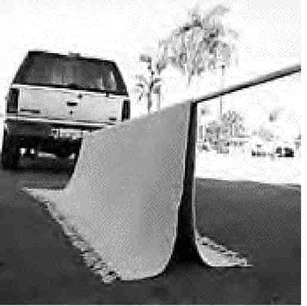
Parachute employed on a tow/tugline
Install what I call a parachute. This is a blanket, sleeping bag or other large "cloth" that will act as an airbrake if the yanker breaks. I've seen people use jackets, sweaters and floor mats, but I question little things. You drape the 'chute at the middle of the extended yanker.
I have no data to validate this tradition, but for now, I see no reason to change it. The thought is that if the yanker breaks, the blanket and yanker will lock together and drag the lethal monster to a speedy, harmless stop. Some of the times when I've broken yankers, they have jumped out from under the blanket, or broke beyond it, and still sped along their merry way. But until I perform a definitive test, I practice and recommend you use a parachute.
I have no data to validate this tradition, but for now, I see no reason to change it. The thought is that if the yanker breaks, the blanket and yanker will lock together and drag the lethal monster to a speedy, harmless stop. Some of the times when I've broken yankers, they have jumped out from under the blanket, or broke beyond it, and still sped along their merry way. But until I perform a definitive test, I practice and recommend you use a parachute.
RAISE THE HOOD
Another recommended safety practice is to raise the hood on the vehicle that has the line attached to the front. This is most likely the 4X being towed, but who's to say the tugger isn't pulling backwards. And let there be no doubt, once force is applied, danger is present at both ends. The raised hood acts like a shield to keep a breaking line out of that driver's face. Use a parachute and raise your hood, but avoid the foolish alternative that follows.
FOOLISHNESS
I've heard you can fill one-gallon plastic containers with water, thread the handles along the yanker and presume this will slow the splintered strap down. I haven't tested it, but I don't believe it! If you're truly talking about forces in excess of 20,000 pounds, I see plastic water bottles as either lethal cannon balls or stationary, handle-less containers at best. I believe it would be the latter. If the handle will support 20,000 force-pounds, shouldn't it be able to support 20,000 pounds of weight? Can you picture lifting two or three 4Xs from one plastic handle? I can't! Forget the water bottle trick.
COYOTE CHAIN CAUTION
Your chain may be similar to the Coyote chain I sell. It uses transportation-quality chain and hooks, but it is not intended for an all-out yank. I suspect the hooks won't take it! The stuck Suburban story that follows bears witness to the forces involved. Next time you pass by a Suburban, inspect the size of the front tow hooks. By the time the stuck Chevy was moving on its own, the hooks were considerably straighter!
ASSIGN A DIRECTOR
You primarily need a traffic cop, a director, un jefe, in addition to two rational, competent drivers. This is someone who will clear the onlookers, check the connections and ensure both tuggee and tugger are alert and ready for action. He gives the go-ahead, narrates the continuing process and is prepared to immediately shut down the whole shebang if something goes awry. He should be safely off to the side, visible and within earshot of both drivers. Both drivers should have their director's-side window down to ensure verbal communication.
DEFINE THE DANGER ZONE
Define the danger zone for all to avoid. This applies to participants, spectators, pets, other vehicles and anything of value. My method is an overkill but, understand clearly, yanker break-forces are potentially lethal. I won't argue whether the yanker could do damage in every square inch of the danger zone, I'll only say it's definitely safer outside vs. inside this area.
Here's how to define the danger area. Mentally disconnect the yanker from one end, hold it taut and walk around the tethered end/4X. Do the same for the opposite end. This will draw out something like a figure eight. This is the danger zone. Only drivers and, when absolutely necessary, the director should be within this zone.
AVOID THE TOWLINE
Another general rule is to avoid the towline even during setup. That means don't walk on it, over it and definitely don't straddle it. The assumption is that it could go taut at any time. The testosterone gender is naturally sensitive to and acutely aware of the dangers of straddling a towline.
HOW TO TUG
So a push by hand didn't work and a tow just smoked the tires. The yanker is safely parachuted, the onlookers are outside the danger zone and the director is in place. One at a time, he calls to the front, then rear drivers, "Are you ready?" When both acknowledge, "Yes," the process begins.
First, give traction another try. Take out all of the slack and try to gentle pull. It's fair to give it a couple of goes, but you don't need to bury yourself trying. If crawl doesn't work, try walk.
Put a couple of feet of slack in the yanker and drive off like no one was attached. If slight progress is gained, do it again. It's completely OK to recover Mr. Stuck a foot or two at a time. It doesn't always have to be a one-shot deal. With no success, cautiously, very cautiously, try run.
Run gets progressively more dangerous. In essence, your 4X and movement add momentum to a traction-only tug. More slack and speed mean more momentum. The tug energy builds with the square of the speed. This means 20 MPH is sixteen times more powerful than 5 MPH! High-speed yanks introduce severe death and damage potential. The yanker is like the energy stored in a giant rubber band. You can think of it roughly like smashing directly into Mr. Stuck at whatever speed you reach. Your airbags go off at a 12 MPH impact! Thank you, Ken Obenski, for the concept and data.
CHANGE SOMETHING
If two or three serious, all-out yanks don't work, I recommend you change something. Experience speaks.
A Suburban tour participant is buried to the frame in Baja mud. His massive weight had stuck him good! A full-size pickup's full-speed tug didn't work (plan A). We put two 30-foot straps in series only to break one strap (plan B). The nylon strap (only) went through the grille and seriously into the air conditioning/radiator. We paralleled two trucks and proceed to yank (plan C). Still no success! We switched to plan D. We jacked it up and put stuff under the tires. Three dirty hours later, the damaged Suburban was out.
The essence of the message is that yankers are great recovery tools, but not always the final solution. Don't kill yourself and others trying to perform the impossible!
Another recommended safety practice is to raise the hood on the vehicle that has the line attached to the front. This is most likely the 4X being towed, but who's to say the tugger isn't pulling backwards. And let there be no doubt, once force is applied, danger is present at both ends. The raised hood acts like a shield to keep a breaking line out of that driver's face. Use a parachute and raise your hood, but avoid the foolish alternative that follows.
FOOLISHNESS
I've heard you can fill one-gallon plastic containers with water, thread the handles along the yanker and presume this will slow the splintered strap down. I haven't tested it, but I don't believe it! If you're truly talking about forces in excess of 20,000 pounds, I see plastic water bottles as either lethal cannon balls or stationary, handle-less containers at best. I believe it would be the latter. If the handle will support 20,000 force-pounds, shouldn't it be able to support 20,000 pounds of weight? Can you picture lifting two or three 4Xs from one plastic handle? I can't! Forget the water bottle trick.
COYOTE CHAIN CAUTION
Your chain may be similar to the Coyote chain I sell. It uses transportation-quality chain and hooks, but it is not intended for an all-out yank. I suspect the hooks won't take it! The stuck Suburban story that follows bears witness to the forces involved. Next time you pass by a Suburban, inspect the size of the front tow hooks. By the time the stuck Chevy was moving on its own, the hooks were considerably straighter!
ASSIGN A DIRECTOR
You primarily need a traffic cop, a director, un jefe, in addition to two rational, competent drivers. This is someone who will clear the onlookers, check the connections and ensure both tuggee and tugger are alert and ready for action. He gives the go-ahead, narrates the continuing process and is prepared to immediately shut down the whole shebang if something goes awry. He should be safely off to the side, visible and within earshot of both drivers. Both drivers should have their director's-side window down to ensure verbal communication.
DEFINE THE DANGER ZONE
Define the danger zone for all to avoid. This applies to participants, spectators, pets, other vehicles and anything of value. My method is an overkill but, understand clearly, yanker break-forces are potentially lethal. I won't argue whether the yanker could do damage in every square inch of the danger zone, I'll only say it's definitely safer outside vs. inside this area.
Here's how to define the danger area. Mentally disconnect the yanker from one end, hold it taut and walk around the tethered end/4X. Do the same for the opposite end. This will draw out something like a figure eight. This is the danger zone. Only drivers and, when absolutely necessary, the director should be within this zone.
AVOID THE TOWLINE
Another general rule is to avoid the towline even during setup. That means don't walk on it, over it and definitely don't straddle it. The assumption is that it could go taut at any time. The testosterone gender is naturally sensitive to and acutely aware of the dangers of straddling a towline.
HOW TO TUG
So a push by hand didn't work and a tow just smoked the tires. The yanker is safely parachuted, the onlookers are outside the danger zone and the director is in place. One at a time, he calls to the front, then rear drivers, "Are you ready?" When both acknowledge, "Yes," the process begins.
First, give traction another try. Take out all of the slack and try to gentle pull. It's fair to give it a couple of goes, but you don't need to bury yourself trying. If crawl doesn't work, try walk.
Put a couple of feet of slack in the yanker and drive off like no one was attached. If slight progress is gained, do it again. It's completely OK to recover Mr. Stuck a foot or two at a time. It doesn't always have to be a one-shot deal. With no success, cautiously, very cautiously, try run.
Run gets progressively more dangerous. In essence, your 4X and movement add momentum to a traction-only tug. More slack and speed mean more momentum. The tug energy builds with the square of the speed. This means 20 MPH is sixteen times more powerful than 5 MPH! High-speed yanks introduce severe death and damage potential. The yanker is like the energy stored in a giant rubber band. You can think of it roughly like smashing directly into Mr. Stuck at whatever speed you reach. Your airbags go off at a 12 MPH impact! Thank you, Ken Obenski, for the concept and data.
CHANGE SOMETHING
If two or three serious, all-out yanks don't work, I recommend you change something. Experience speaks.
A Suburban tour participant is buried to the frame in Baja mud. His massive weight had stuck him good! A full-size pickup's full-speed tug didn't work (plan A). We put two 30-foot straps in series only to break one strap (plan B). The nylon strap (only) went through the grille and seriously into the air conditioning/radiator. We paralleled two trucks and proceed to yank (plan C). Still no success! We switched to plan D. We jacked it up and put stuff under the tires. Three dirty hours later, the damaged Suburban was out.
The essence of the message is that yankers are great recovery tools, but not always the final solution. Don't kill yourself and others trying to perform the impossible!
© Harry Lewellyn
Ecological 4-Wheeling Adventures
2234 Catherine Pl.
Costa Mesa, CA, 92627-1815
Phone (949) 645-7733
FAX (949) 645-7738
E-mail: [email protected]
http://4wdadventures.com

